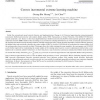Free Online Productivity Tools
i2Speak
i2Symbol
i2OCR
iTex2Img
iWeb2Print
iWeb2Shot
i2Type
iPdf2Split
iPdf2Merge
i2Bopomofo
i2Arabic
i2Style
i2Image
i2PDF
iLatex2Rtf
Sci2ools
IJON
2007
2007
Convex incremental extreme learning machine
Unlike the conventional neural network theories and implementations, Huang et al. [Universal approximation using incremental constructive feedforward networks with random hidden nodes, IEEE Transactions on Neural Networks 17(4) (2006) 879–892] have recently proposed a new theory to show that single-hidden-layer feedforward networks (SLFNs) with randomly generated additive or radial basis function (RBF) hidden nodes (according to any continuous sampling distribution) can work as universal approximators and the resulting incremental extreme learning machine (I-ELM) outperforms many popular learning algorithms. I-ELM randomly generates the hidden nodes and analytically calculates the output weights of SLFNs, however, I-ELM does not recalculate the output weights of all the existing nodes when a new node is added. This paper shows that while retaining the same simplicity, the convergence rate of I-ELM can be further improved by recalculating the output weights of the existing nodes base...
Related Content
| Added | 15 Dec 2010 |
| Updated | 15 Dec 2010 |
| Type | Journal |
| Year | 2007 |
| Where | IJON |
| Authors | Guang-Bin Huang, Lei Chen |
Comments (0)

